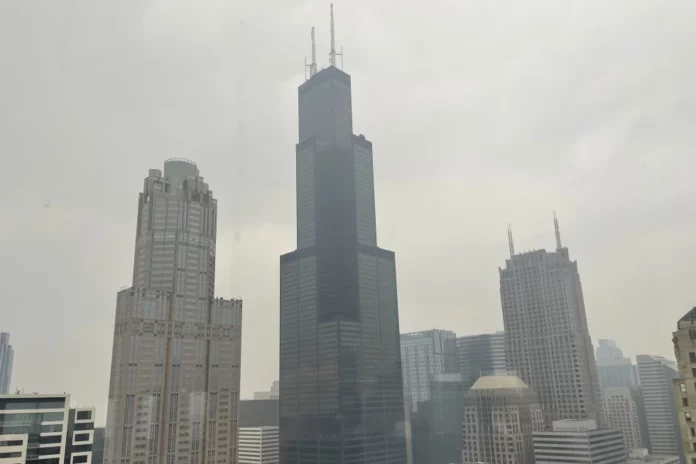
For Chicagoans planning a lengthy outdoor run Monday, “today is not necessarily the day for that,” according to Kim Biggs of the Illinois Environmental Protection Agency.
Extensive swaths of the northern United States awoke to unhealthy air quality Monday morning or were experiencing it by midafternoon, according to the Environmental Protection Agency’s AirNow.gov Smoke and Fire map.
Fine particle pollution caused by smoke from Canada’s wildfires is causing a red zone air quality index, meaning it is unhealthy for everyone. The particles, known as PM2.5, are tiny enough to get deep into the lungs and cause short-term problems like coughing and itchy eyes, and in the long run, can affect the lungs and heart.
The EPA advises keeping outdoor activities light and short when air quality indexes reach above 150 on the agency’s map. On Monday afternoon, cities and regions hitting that mark included Lincoln, Nebraska; Peoria, Illinois; Fort Wayne, Indiana; Cleveland and Columbus in Ohio; Huntsville, Alabama; Knoxville and Chattanooga in Tennessee; Greensboro, North Carolina; Pittsburgh, Pennsylvania; and Syracuse and Utica in New York.
Sensitive groups, including people with heart and lung disease, older adults, children, and pregnant women, should consider staying inside, advisories warn.
Although air quality was poor in the Chicago region earlier Monday, it has already improved to moderate quality and was expected to continue doing so throughout the day, Biggs said.
Relief from the smoke crossing the Canadian-U.S. border won’t be immediate, experts said. Large fires in Alberta, British Columbia and Saskatchewan are likely to keep churning out smoke throughout the summer and possibly into early fall, said Montana Department of Environmental Quality meteorologist Aaron Ofseyer.
“The worst is over with this round,” Ofseyer said. “Unfortunately, there’s still a ton of wildfire smoke north of the border. Anytime we get a North wind, we’re going to be dealing with Canadian wildfire smoke.”
Climate change and rising temperatures cause the environment to be more prone to wildfires, and more susceptible for air masses to become stagnant and stationary, explained Dr. Ravi Kalhan, a pulmonologist and professor of medicine and preventative medicine at Northwestern University’s Feinberg School of Medicine.
“It’s not normal,” he said of the repeated air quality alerts experienced by the Midwest this summer.
“We keep having these events. They’re not just one bad day a year,” Kalhan said.
The Canadian Interagency Forest Fire Centre website reported 882 active fires, with 581 deemed “out of control,” as of Monday afternoon.
Republished with the permission of The Associated Press.













